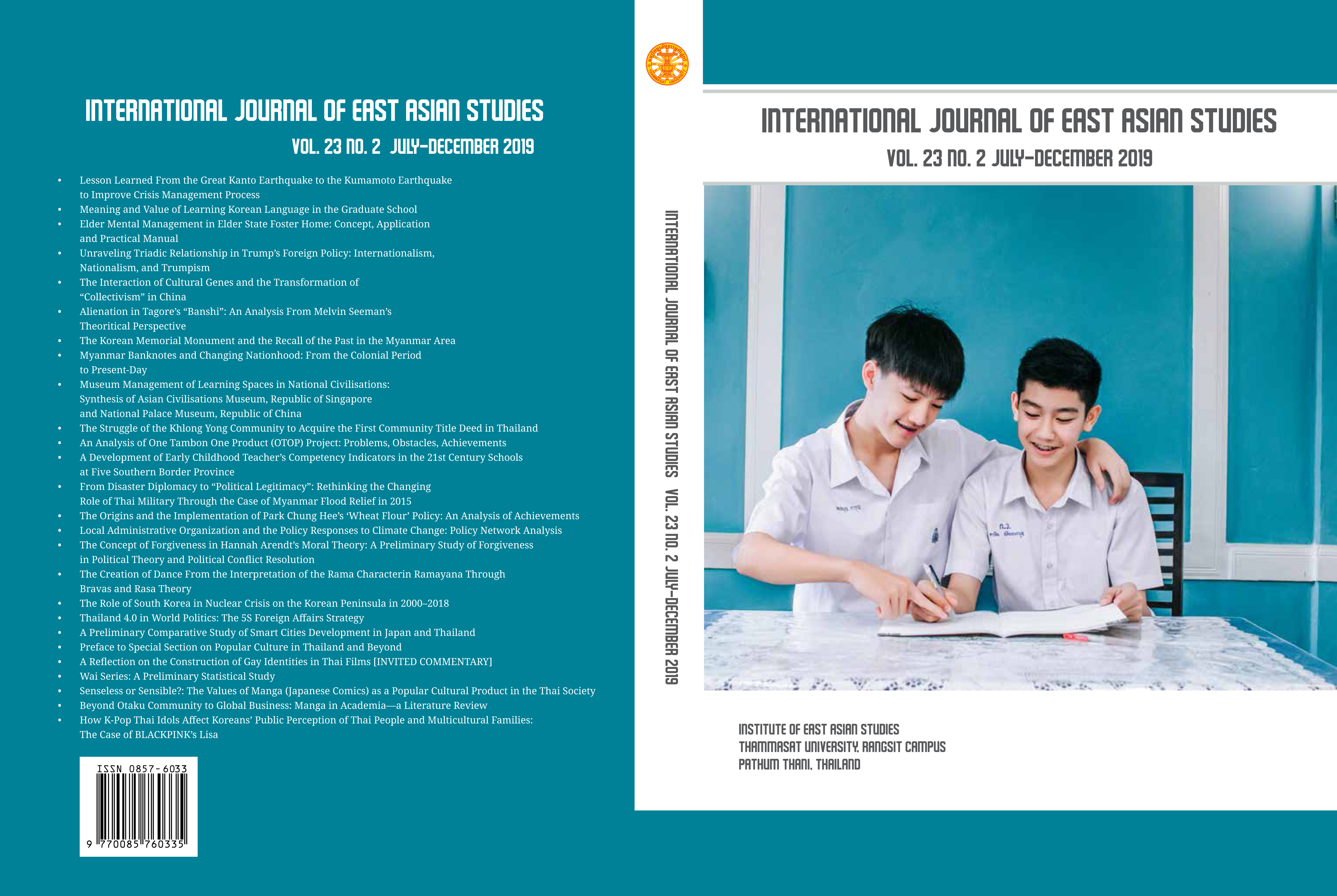How K-Pop Thai Idols Affect Koreans’ Public Perception of Thai People and Multicultural Families: The Case of BLACKPINK’s Lisa
Keywords:
K-pop, BLACKPINK Lisa, Thai people, image, Korean PublicAbstract
This study explores what impact Thai K-pop idols have had on the Korean public’s perception of Thai people. The purpose of this study is to analyze the general image of Thai people held by Koreans. To do so, it examined how Koreans’ biased image of Thai people, shaped by the reports of Korean media and looked into one specific incident surrounding BLACKPINK Lisa to analyze the news reports on this incident and the reactions and opinions of Koreans expressed online.
Koreans group foreign workers as Southeast Asians and see them as criminals who cause social problems. And Koreans have a biased perception that multicultural families are mostly formed through the marriage between a Korean man and a Southeast Asian woman and think that these families are social minority groups that need to be treated with sympathy. However, the influence of Thai idols on the media such as Lisa on the perceptions of the Korean public is found to be positive. Even when the issue of racial discrimination was raised surrounding Lisa, many netizens criticized and self-reflected on the racial discrimination in Korea.
Downloads
References
Kim, E. (2017). (The) Influence of "Thai Wave" celebrities in Korean popular culture on the Thai peoples' image held by Koreans: focusing on Thai K-pop idols (Master’s thesis, Graduate School of International Studies, Seoul National University, South Korea).
Lee, G. (2009). A theory of soft power and Korea’s soft power strategy. Korean Journal of Defense Analysis, 21(2), 205-218.
Said, E. (1978). Orientalism. New York: Pantheon
เอกสารภาษาเกาหลี
[A posting on an Internet forum]. (2019, January 18). Retrieved from Instiz website: https://www.instiz.net/name_enter/60030761
Commissioner of Statistics Korea. (2018). 2017 Multicultural population trends statistics. Retrieved from Statistics Korea website: http://kostat.go.kr/portal/korea/kor_nw/1/2/3/index.board?bmode=read&aSeq=371776&pageNo=&rowNum=10&amSeq=&sTarget=&sTxt=
Eom, H. (2008). Korean Society through Multiculturalism: Character of tolerance and Social Background towards immigrants. Korean Journal of Sociology Symposium, 37-45.
Hwang, R., Choi, H., & Kim, Y. (2012). K-POP & K-POP Star Influences on the National Image and Korea-Made Goods’ Purchasing Intention. Journal of the Korea Entertainment Industry Association, 6(4), 5-14.
Im, Y. J. (2012). Comparative Analysis of Media on Migrant Workers in Korea: With an emphasis analyhsing Chosun Ilbo, Hankyoreh, Kyoungin and Busan Ilbo. Korea Regional Communication Research Association, 12(4), 419-456.
Jang, M. J. (2013). Multicultural Discourse Analysis in Media. Multicultural Education Studies, 6(3), 157-179.
Jeong, H., Park, S., & Jun, H. (2017). The Determinants of Migrants’ Experience of Discrimination: Considering Structural, Cultural, and Environmental Perspectives. Korean Journal of Administration, 55(4): 307-336.
Jun, E. (2015). “Good Migrant, Bad Migrant” Developmentalism in South Korean Discourse of Migration and Anti-Damunhwa. Economy and Society, 106, 238-270.
Kim, H. M. (2014). The Spread of Racialism and ‘No Nation’. Presentation at The 2014 Report of Korean Society Racism.
Kim, J., & Han, K. (2013). The Sources of Korean University Students’ Discriminative Consciousness Towards Foreigners: A Critical Analysis of the Discourses on Ethnic Nationalism, Civilization, and ‘Seonjinguk’. The Korean Association of Socio-Historical Studies, <Discourse 201>, 16(3), 35-66.
Kim, J., & Kim, K. (2005). The Changes of Korean Image thorough ‘Korean Wave’ in Japan. The Journal of Humanities, 10, 23-48.
Kim, Y. (2016, August 5). Re: D-3 to Debut’ BLACKPINK Lisa, Her Exotic + Chic Look. Retrieved from Sports Chosun website: http://sports.chosun.com/news/ntype.htm?id=201608060100051680003467&servicedate=20160805
Kim, Y. (2017, January 7). Re: Pure and Innocent Beauty in Blond, BLACKPINK Lisa Shakes Men’s Hearts with Her Doll-like Looks. Retreieved from Sports Chosun website: http://sports.chosun.com/news/ntype.htm?id=201701080100049520003178&servicedate=20170107
Kim, T. (2019, January 18). Re: Koreans are racially discriminating Lisa’… Why fans in Thailand are angry about the racial discrimination of BLACKPINK member Lisa, YouTube videos condemning the situation centering on foreign idol group members raising concern over ‘creating negative image of Korea. Retrieved from Sunday Newspaper website: http://ilyo.co.kr/?ac=article_view&entry_id=322992
Lee, C. (2013). New Korean wave and cultural topography, Seoul: Nonhyung.
Lee, J. (2019, April 15). Re: BLACKPINK Lisa becomes No. 1 in the number of Instagram followers among domestic celebrities. Retrieved from Seoul Newspaper website: https://www.seoul.co.kr/news/newsView.php?id=20190415500203&wlog_tag3=naver
Moon, S. Y. (2006). A Study of orientalism in Korean Movie: a textual analysis Failan. PNU Journals of Womens Studies, 16(11), 269-277.
Park, B., & Jung, K. H. (2004). Globalization and the Politics of “Forgetting”: A study on a Foreign Immigrants Community in Wongok-dong, Ansan. Journal of the Korean Association of Regional Geographers, 10(4), 800-823.
Park, C., Jung, H., Kim, M., & Ahn, J. (2008). A Study on the Improvement of Broadcasting Access Right of the Foreigners in Korea: Providing English Subtitle of IPTV Korea Culture Program. Seoul: KCC.
Paek, Y. P. (2019, April 11). Re: Galaxy A’ uses BLACKPINK as model…… Will Samsung Electronics become No. 1 again in Thailand?. Retrieved from Bridge Economy website: http://www.viva100.com/main/view.php?key=20190411010004121
Roh, S. H., & Cho, J. (2014). Why do foreigners in the neighborhood make people fear crime?: The impact of perceived proximity to foreigners upon perceived risk of crime. Journal of Korean Criminological Association, 8(2), 281-321.
Shim, D. (2013). An Essay on K-pop: Korean Wave, Idols, and Modernity. Social Studies Education, 52(2), 13-28.
Song, J. E., & Jang, W. (2013). Developing the Korean Wave through Encouraging the Participation of YouTube users : The Case Study of the Korean Wave Youth Fans in Hong Kong. Journal of the Korea Contents Association, 13(4), 155-169.
Sung, J. S. (2019, January 22). Re: BLACKPINK Lisa, the New Muse of Celine’s Hedi Slimane… ‘Mysterious, Beautiful’. Retrieved from http://star.mk.co.kr/v2/view.php?mc=ST&year=2019&no=45006
Won, S. (2012). Old or New? The Multi-dimensionality of Racism and Its Effect on Acceptance of Policy for Racial Minorities: An American Experience. Korean Journal of Public Administration, 50(4), 105-134.
Yoo, M. (2010). A Study on the Multiculturalism and Multicultural Policy in Korea. Asia-studies, 13(2), 83-109.



